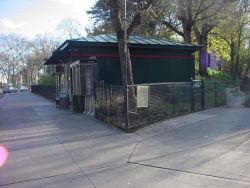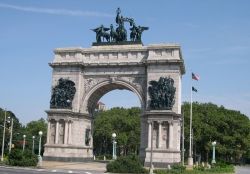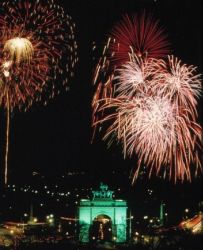Grand Army Plaza
Grand Army Plaza
Grand Army Plaza, the oval at the main entrance of Brooklyn’s Prospect Park, was meant to provide a wide and picturesque approach to the park, which park designer Calvert Vaux (1824–1895) considered a vital design element. The Plaza was one of the first features of Prospect Park to be built and marks the beginning of the Eastern Parkway (1866), the world’s first parkway, also designed by Vaux and his partner Frederick Law Olmsted (1822–1903). The parkway’s intended purpose was to connect the City’s parks with ornamental roads free of commercial traffic.
As the need for open spaces in Brooklyn increased, the New York State Legislature authorized the City of Brooklyn, in 1859, to select sites for public parks. In 1860 a Parks Commission was created which selected the site for Prospect Park. The Commission was led by James S.T. Stranahan (1808–1898), known as “the Father of Prospect Park.” Stranahan served as the board’s president for 22 years, and is honored in Grand Army Plaza with a portrait sculpture by Frederick MacMonnies (1863–1937) dedicated in 1891.
Construction on Prospect Park was stalled during the Civil War, but resumed in 1865, when Vaux was asked to submit new plans for the space. His new plan called for an elliptical piece of land at the main entrance to the park, known then as simply “the Plaza.” In 1866, the Plaza began to be graded and its interior paved with granite Belgian blocks and, in 1867, the Plaza’s distinctive mounds were built. Subsequent years saw the addition of gas-fueled lamps (not always functioning because of Brooklyn’s unsteady gas supply), trolley tracks, and a fountain at the Plaza’s center. Brooklyn Parks officials estimated that over 11 million people visited Prospect Park in its first five years of operation; most visitors entered the park through the Plaza’s grand entrance.
The economic panic of 1873 stalled significant work on the Plaza during much of the 1870s and by 1887, the Parks Commission clamored for the Plaza to be rebuilt, calling the design a “failure.” “It is devoid of all life and a stony waste,” the Commission noted in its 1888 Annual Report. “It is suggestive of Siberia in winter and Sahara in the summer.”
Major reconstruction of the Plaza was marked by the construction of the Soldiers’ and Sailors’ Arch, which began in 1889. The Arch was dedicated in 1892 as the noted architectural firm of McKim, Mead and White began to formalize the entrance and transform the Plaza into a classical space. The Plaza’s four Doric columns were added between 1894 and 1896, the north mound was extended, the other mounds cleared and replanted, and the land around the arch paved with brick. Electric lamps replaced the gas lamps and the trolley tracks were relocated so that they crisscrossed north of the Arch. The rusty and inefficient 1870s fountain was replaced with an electric fountain in August 1897, whose opening was attended by a reported 20 to 30,000 people.
Much of the statuary was added in this period, including Gouverneur Kemble Warren (1896), Henry Maxwell Tablet (1903), Alexander J.C. Skene (1905), and Henry Warner Slocum (1906). The quadriga on the Arch was installed in 1898 and the Arch’s side sculptures were added in 1901 as the Plaza began to be referred to as Grand Army Plaza, honoring the Arch’s subject matter, the triumphant Union Army and Navy of the Civil War.
From 1915 to approximately 1920, the Plaza was cut open to make room for the BMT and IRT subway lines. The underground tracks necessitated the removal of the electric fountain, which gave way to a grass oval. Construction on the current Bailey Fountain began in 1928 and was completed in 1932. With the advent of the automobile, the busy junction of streets around the Plaza became increasingly dangerous and a “Death-O-Meter” was installed at the Plaza in 1927 that kept track of Brooklyn automobile fatalities. By the 1950s, the Plaza was dominated by traffic; over 40 traffic signals were added in 1955, and the roadway was entirely repaved in 1958.
The bust of John F. Kennedy was added in 1965. In 1973 the Arch was designated an official City landmark, and in 1975 the entire Grand Army Plaza was designated such as well. In 1976 the Victory figure on the quadriga on top of the Arch fell out of its chariot. The Arch was restored in 1980 and again in 2000.
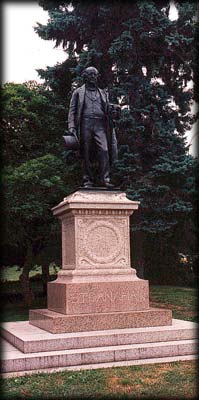
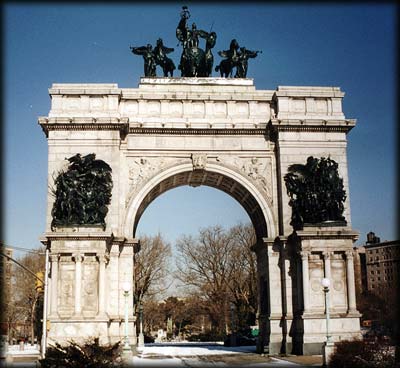
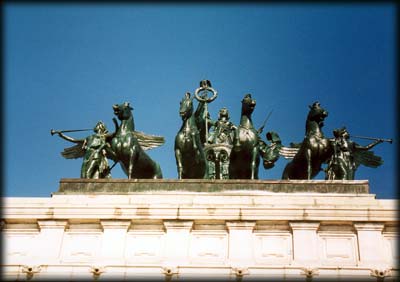
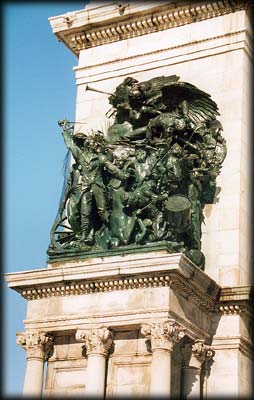
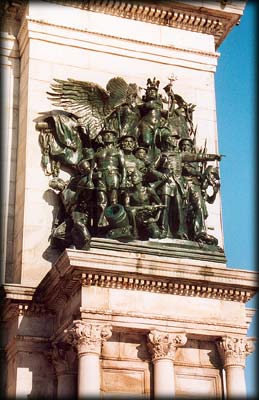
Check out your park's Vital Signs
Clean & Safe
Green & Resilient
Empowered & Engaged Users
Share your feedback or learn more about how this park is part of a
Vital Park System


